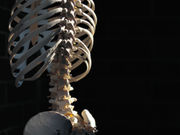Novel loci identified for discordant multi-dimensional skeletal phenotypes
THURSDAY, Dec. 21, 2017 (HealthDay News) — Established bone fragility variants are associated with a concordant phenotypic model of the pediatric skeleton but not with discordant phenotypic models, according to a study published online Dec. 14 in the Journal of Bone and Mineral Research.
Jonathan A. Mitchell, Ph.D., from the Children’s Hospital of Philadelphia, and colleagues applied a multidimensional phenotyping approach to examine the genetic regulation of pediatric areal bone mineral density (aBMD). Data were obtained from a prospective, longitudinal cohort of 1,293 children of European ancestry. The authors tested the correlation between a genetic score (percentage of bone-lowering alleles at 63 loci) and each principal component. Novel loci associated with these principal components were identified in a genome-wide association study (GWAS) using the multi-ethnic baseline data (1,885 individuals).
The researchers found that the first component (PC1) reflected a concordant phenotypic model of the skeleton, while PC2 and PC3 were discordant for distal radius versus spine and hip and for spine versus distal radius and hip aBMD, respectively. The genetic score was correlated with PC1 but not with discordant PC2 or PC3. Variation near CPED1 was associated with PC2, and variation near RAB11FIP5 was associated with PC3 in the GWAS.
“An established bone fragility genetic summary score was associated with a concordant skeletal phenotype, but not discordant skeletal phenotypes,” the authors write. “Novel associations were observed for the discordant multi-dimensional skeletal phenotypes that provide new biological insights into the developing skeleton.”
Copyright © 2017 HealthDay. All rights reserved.








